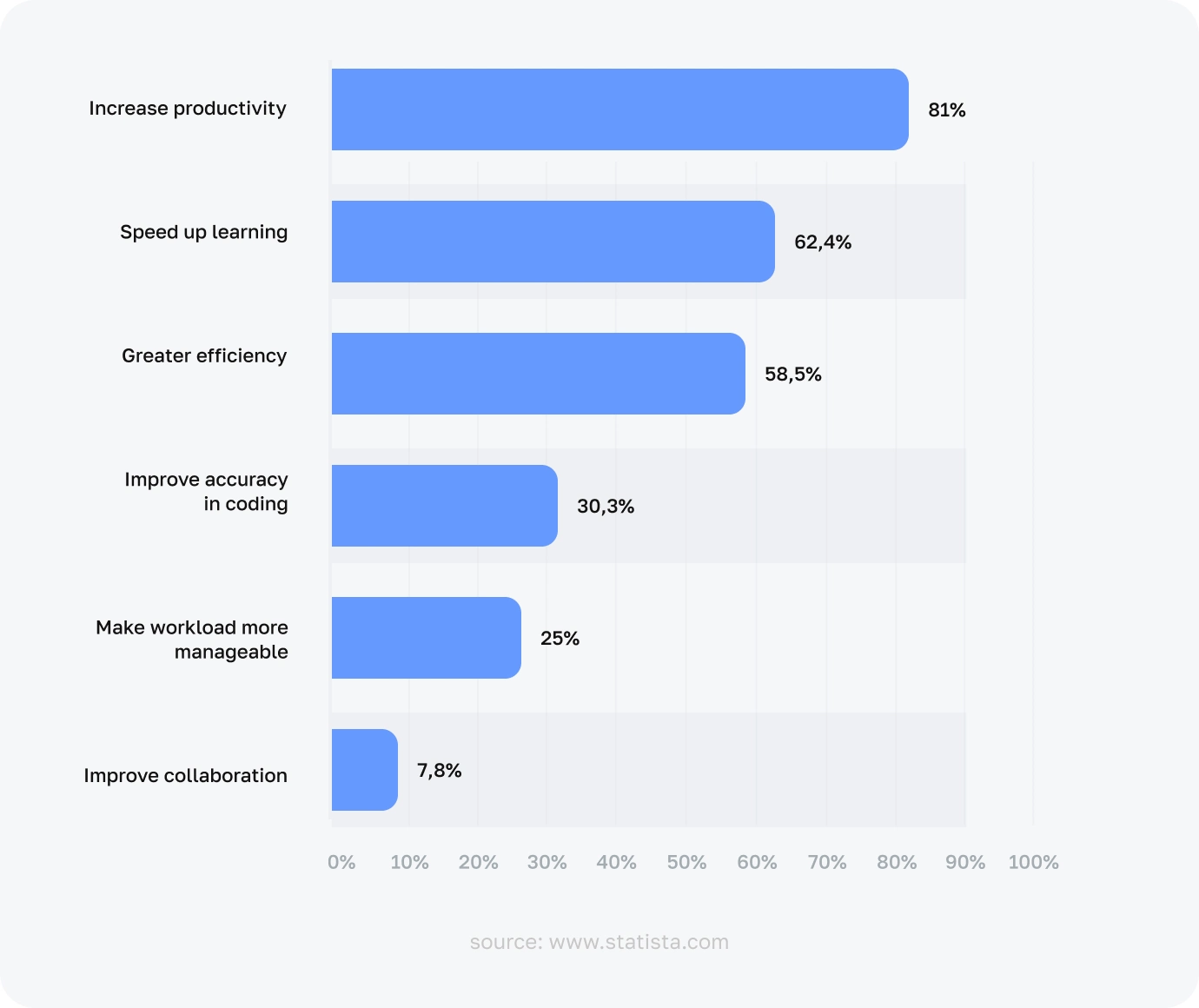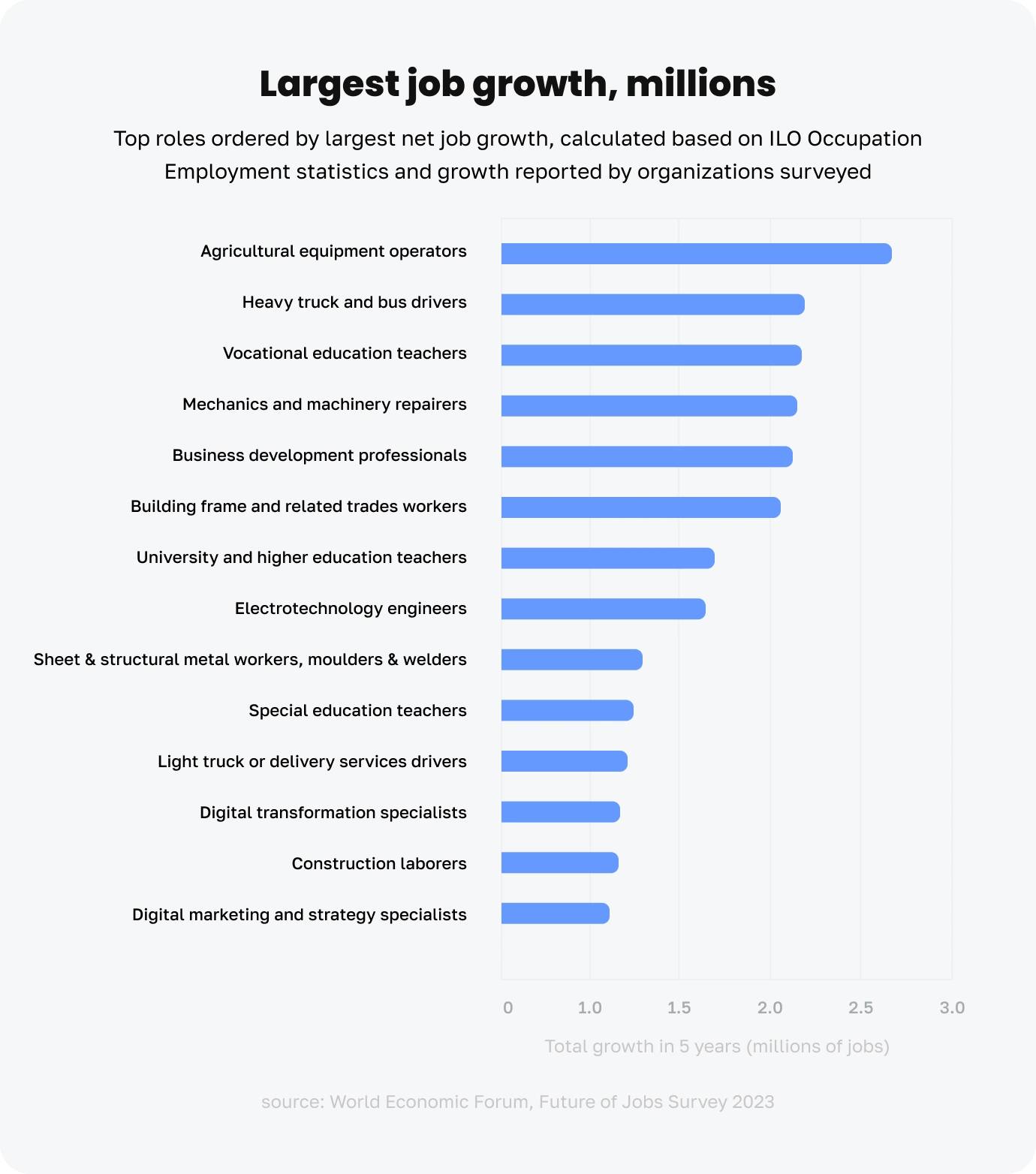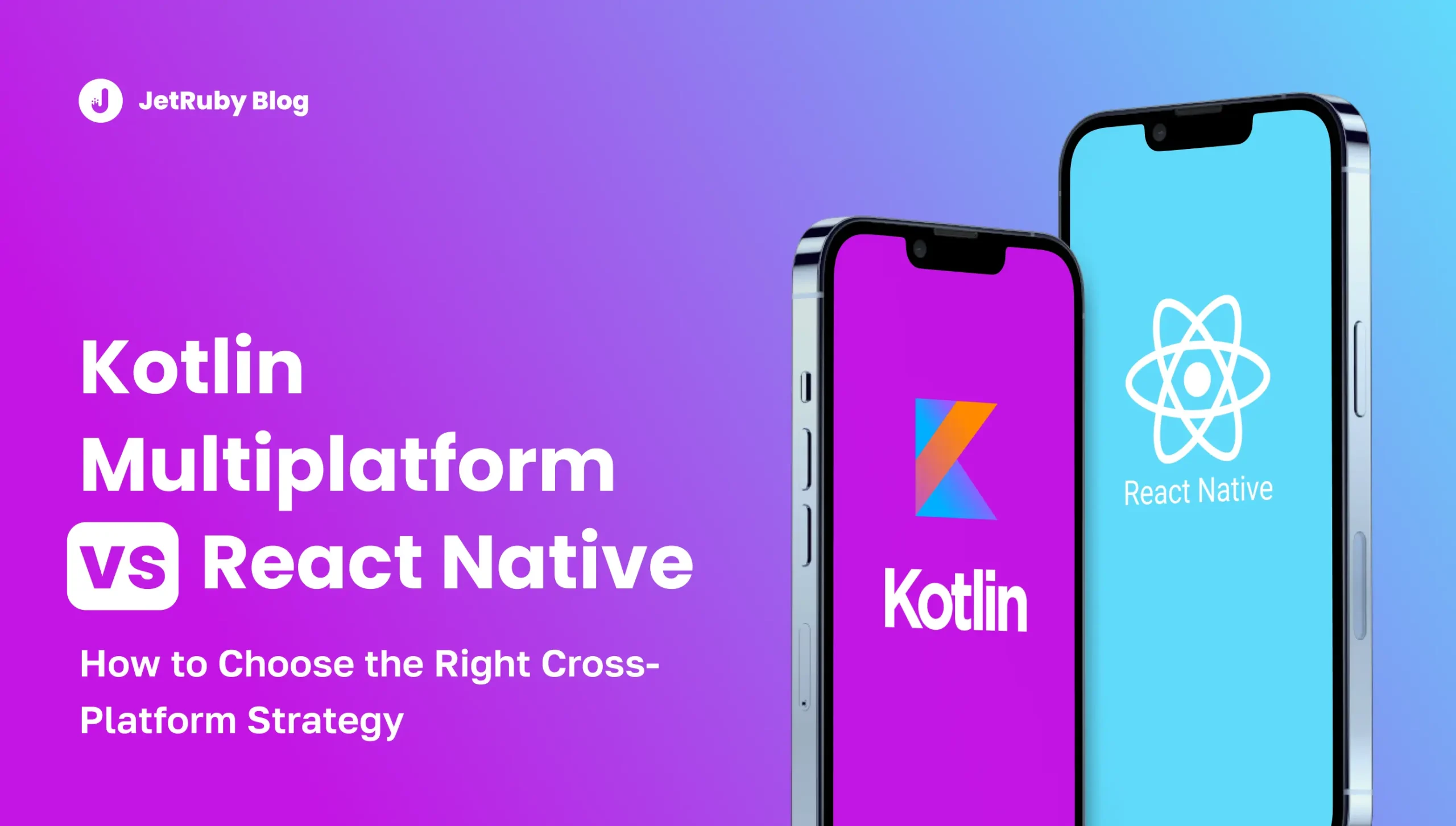Table of Contents
Fun fact: In 2023, AI adoption grew by 270%, yet unemployment hit a 50-year low.
Nevertheless, headlines about AI destroying jobs or AI stealing jobs dominate the media.
The fear of AI taking jobs comes from predictions of machines outsmarting humans or robots making entire skill sets obsolete.
That naturally sparks anxiety: Will your job be at risk in a year, or even six months? Will entire professions vanish overnight?
It’s easy to see why people worry about AI.
However, the fear of artificial intelligence and such apocalyptic scenarios often ignores history, real-world data, and the fact that humans are incredibly adaptable.
Let’s break it down.
Key Takeaways
- AI automates tasks, not roles: AI will not take over jobs, but enhance them.
- Emotional intelligence cannot be replaced. Jobs that require empathy and understanding, like therapy, leadership, and customer service, still depend on humans.
- The World Economic Forum’s report predicts that new “jobs of tomorrow” will be created faster than the number of jobs that will be lost.
- Critical thinking > automation. In fields like law, medicine, and research, people should use AI as a tool to support their own judgment, not as a replacement.
- Upskilling is key for the future. The future rewards those who combine technical skills with human abilities.
- Collaboration > competition. AI excels at tasks that need speed, like reviewing documents. Meanwhile, Humans focus on strategy and creativity, showing how AI and humans can work well together.
AI in the Workplace: Adaptation, Not Replacement
Recent findings from McKinsey’s 2024 report shed some light on the true state of AI in the workplace. An impressive 71% of companies now employ artificial intelligence in tasks such as AI task automation for routine work, administrative help, and even preliminary decision-making.
Yet, many of these businesses don’t fear of AI taking jobs. They believe AI won’t replace us because a lot of jobs require human connection.
That’s a major disconnect from the constant drumbeat warning about “AI taking jobs.” In reality, jobs evolve and shift rather than just vanish.
Why the discrepancy?
A big part of it comes from the nature of AI itself.
AI excels at well-structured, predictable tasks, like analyzing massive datasets at unimaginable speeds for human employees. But it’s still limited regarding emotional intelligence, moral reasoning, and genuine creativity.
Think of a chatbot that can answer basic customer questions. It can parse keywords in a query, pull from a script, and spit out a response. But it can’t truly grasp the emotional context behind someone’s frustration or tailor a response with heartfelt empathy.
These are qualities that remain uniquely human.
The demand for AI-related skills in general is truly on the rise.
But if we look back through history, from the industrial revolution to the digital age, new technologies haven’t eradicated the workforce but reconfigured it. The key, it seems, is to adapt rather than resist.
Therefore, focus on improving skills in areas where AI has difficulty. This will help you succeed in a world that is becoming more automated.
Creativity and Emotional Intelligence: Why AI Can’t Compete
One of the most significant differences between humans and artificial intelligence is our capacity for creativity and emotional depth.
AI can generate a high volume of ideas in a fraction of the time it takes a human. In fact, generative AI models can produce anything from blog posts to digital art, and some look pretty convincing.
AI does not truly get “inspiration.” Instead, it looks at data patterns from existing content to create something new. This new content may seem original, but it is really based on statistical chances.
For instance, let’s say you ask an AI image generator to create a concept for a futuristic automobile. It will analyze countless images of cars, identify patterns (like shapes, textures, angles), and then combine those elements into something that seems novel.
While that might appear creative, it lacks the emotional or cultural context that a human designer brings.
One might say, “I’m getting ideas from nature,” or “I want this design to bring back memories of 1960s muscle cars.” AI alone doesn’t create that. It can only mix existing patterns with little to no emotional context at the moment.
This difference matters even more when you factor in emotional intelligence.
AI can be trained to recognize facial expressions or words that show someone is upset. However, it doesn’t truly feel empathy. It analyzes data like expressions or phrases and gives them a probability label, such as “this user is 78% likely to be angry,” and then provides a set response.
In contrast, humans can pick up on subtle cues, like a quiver in someone’s voice, signs of frustration in their body language, or even the context of that person’s emotional history.
- Example: Ad agencies often use tools like Midjourney or DALL·E to create concept sketches and brainstorm different layouts quickly. However, the emotional appeal, such as a tagline that connects with a specific cultural moment, usually comes from a person. While machines can make educated guesses, only humans can truly understand those emotions.
- Emotional marketing raises the chances of conversion by 70%. While AI can provide relevant images or even write a basic draft of marketing copy, truly connecting with people’s emotions requires understanding cultural values, personal experiences, and local context. These are areas where AI still struggles.
Instead of seeing AI as something that will replace jobs, we should view it as a tool that makes work faster. AI can help with the early stages of generating ideas, allowing creative professionals to focus on refining their work and developing deeper concepts.
So, creative industries are not as threatened as some might think. In fact, they can benefit from using AI to improve efficiency while keeping the important human elements that connect emotionally with people.
Critical Thinking: The Human Edge
Critical thinking means combining different types of information to make a decision. This information can be based on data, context, or intuition.
Computers analyze data, but they struggle with nuance and ambiguity. When they face conflicting information or need to make moral decisions, AI cannot think creatively. It follows rules or patterns from past data and cannot adapt without reprogramming or retraining.
Think about legal tasks. AI can quickly analyze thousands of case files and laws to provide a lawyer with relevant precedents, saving time.
However, creating a legal strategy, predicting the opposing lawyer’s moves, reading jury reactions, and understanding local culture still rely on a lawyer’s experience, emotional intelligence, and creativity.
AI can help you find the right cases and suggest possible arguments. However, it doesn’t have the deep understanding of human conflict and resolution that an experienced lawyer gains from years of practice.
For example, in large law firms, lawyers use AI tools more often to review documents. While AI can identify patterns and highlight specific phrases, lawyers still need to understand the details.
If evidence is unclear, AI cannot think through its own “thoughts” or guess the context. A human lawyer, however, can catch subtle hints and understand the underlying messages.
Researchers at the University of Toronto pointed out that making decisions usually involves predicting the results and figuring out if those results are good.
This finding highlights the unique value of humans in problem-solving roles, such as strategic planning and conflict resolution. Rather than just following scripts, we can question, modify, or create new strategies.
AI + Humans = Stronger Outcomes
Instead of seeing AI and humans as competitors, consider them a strong team. AI is great at quickly sorting through large amounts of data, finding unusual patterns, and making suggestions.
Humans can review these suggestions thoughtfully, consider emotions and ethics, and create well-rounded solutions that machines can’t come up with on their own.
GitHub Copilot shows how AI can assist developers. It analyzes public code to suggest lines or blocks, saving time on repetitive tasks.
A human engineer must then review these suggestions to ensure they address the problem, follow security rules, and align with the organization’s coding standards.
The 2024 Stack Overflow developer survey found that over 80% of developers believe AI tools make them more productive. This is a big jump from 33% in 2023. Additionally, 62% said AI helps them learn faster, and 59% said it makes their work more efficient.
AI takes care of routine tasks, so employees can focus on generating new ideas, improving user experiences, or working on more complex tasks that require strategic thinking.
Want to retain your best people while introducing AI? Read JetRuby’s guide on the 13 ways to reduce employee turnover.
The best results come when AI and people work together. Companies that effectively use AI while valuing human insight outperform those that rely on old methods or automate carelessly. The key is to use AI for efficiency while maintaining the qualities that make us valuable decision-makers.
Fear of AI Taking Jobs — Will It Take All of Them?
The fear that new technology “kills jobs” has been around for centuries. From the textile mills of the Industrial Revolution to the dawn of the Internet, every leap forward is met with predictions of unemployment crises.
And while some jobs do become obsolete, new roles usually emerge in tandem, often higher-skilled, better-paying roles that leverage the new technology.
So, should you be worried about AI taking your job?
Look at bank tellers as an example. After the widespread adoption of ATMs, many assumed bank teller positions would vanish.
Indeed, they declined by 30% over the years. However, BLS shows that more complex financial advisory roles, such as personal financial advisors, are expected to grow by 17% from 2023 to 2033. Similarly, jobs that won’t be affected by AI will evolve into higher-value tasks.
What happens is that the nature of banking is changing.
Many bank employees have moved away from just doing basic transactions. They now focus more on helping customers, managing relationships, and selling financial products. These tasks require empathy and judgment, which are more important than simple counting.
And this cycle happens in many industries.
Grocery store checkout lines now have self-service kiosks, but this doesn’t mean retail jobs will disappear. Instead, the focus shifts from scanning items to helping customers, managing inventory, or taking on more specialized tasks that need human attention.
People often forget that when tasks are automated, companies usually move human workers to tasks that create more value.
Workers can do well in roles that require flexibility and personal interaction, like cross-selling new services or providing better customer care. Meanwhile, businesses gain from the efficiency that automation brings.
If your business needs to adapt, here’s how to pivot effectively without losing direction.
Let’s look at doctors and pharmacists. AI is already helping diagnose diseases, predict patient risks, and even recommend medications. Some fear this means machines will replace human clinicians. But the reality is more nuanced.
Doctors won’t lose their jobs to AI. Instead, AI will handle routine tasks like analyzing lab results or flagging anomalies in scans.
Here’s the thing about healthcare — it shows why some jobs just can’t be automated.
Think about it: you don’t just grab medicine off a shelf when you’re sick. You see a doctor who listens to your symptoms, checks your history, and makes a judgment call. Then a pharmacist double-checks everything to make sure you get exactly what you need, in the right amount.
And it’s not about bureaucracy at all because we need to keep people safe. Some decisions need human judgment: understanding nuances, weighing risks, and making ethical calls. A computer can’t look you in the eye or pick up on subtle cues that something’s not quite right.
And that’s why certain professions, especially in fields like healthcare, aren’t going anywhere.
You can’t shortcut the system because the system exists for good reason. For all the amazing things AI can do, there are some areas where we’ll always need that human touch, at least for the foreseeable future.
The same pattern holds across healthcare. Nurses might spend less time on paperwork and more on bedside care. Radiologists could rely on AI for initial image analysis but still make the final call.
The core of medicine, like listening, empathizing, and making judgment calls, remains deeply human.
Debunking the “Economic Apocalypse” Myth
Some media outlets say robots will take all the jobs, leaving humans unemployed. However, history and current data show a different story. Technology can change traditional jobs, but the economy usually adapts by creating new jobs that didn’t exist before.
New jobs appear for everyone AI displaces, according to the World Economic Forum’s Future of Jobs Report 2023.
That might look surprising, but it aligns with past technological shifts. For example, the Internet eliminated certain “offline” roles (think of travel agents or video store clerks), but simultaneously spawned jobs in e-commerce, digital marketing, social media management, and more.
What about wage stagnation or growing inequality?
That is a valid concern. Technology can lead to wealth concentration if our policies and education do not keep up.
However, we should not stop progress — we must invest in workforce training. Governments, businesses, and individuals should ensure that training in AI-related fields is available. This will help employees move into new roles as old ones become less relevant.
People fear an “economic apocalypse” because they think more jobs will be lost than created, but the data does not support this idea. Instead, it shows that proactive steps like education, skill development, and supportive laws can help the workforce grow with technology.
The bottom line? Should we fear of AI taking jobs?
No, because AI transforms jobs, not eliminates them!
How to Future-Proof Your Career
Concerned about keeping up in the AI economy?
Balance technical skills with soft skills that AI can’t easily replicate.
- Learn about AI Tools: A basic understanding of machine learning, prompt engineering, and data management can help you stand out. Websites like Coursera, edX, or coding bootcamps offer easy ways to get started. Learning the basics will help you understand where AI can help and might not work well.
- Focus on Soft Skills: Emotional intelligence, communication, leadership, and negotiation. These are skills and jobs AI can’t replace. They take years to develop and are in high demand because AI struggles to replicate them. Understanding feelings, resolving conflicts, and making thoughtful decisions are things only humans can do well. Invest in personal development courses, workshops, or hands-on experiences to improve these skills.
- Keep Learning: Technology is changing quickly, and it won’t slow down. Treat your education and training as an ongoing journey, not a one-time event. Regularly update your skills. Look for new certifications, stay updated with industry trends, and be open to changing your career path if a new opportunity comes up.
Want to see how top-tier companies assess talent? Here’s a look inside JetRuby’s hiring process for high-performing engineers.
- Use AI as a Helpful Tool: If you are a marketer, let AI examine customer data to find patterns. This gives you more time to create your marketing message. If you are a project manager, let AI take care of scheduling so you can focus on your team and planning. For instance, JetRuby built a custom ERP system to help businesses automate scheduling, reporting, and operations without losing human oversight.
Using these strategies shows that you can use AI’s efficiency while still providing the personal, creative, and ethical insights machines cannot offer.
Should we fear A.I.? Only if we ignore how humans adapt.
So, should we worry about AI? Maybe a little, but worry should drive action, not paralysis.
Why JetRuby’s CTO Co-Pilot Is Your AI Ally
Integrating AI can seem daunting for midsize businesses, especially if you don’t have a large tech team. You might think you need to hire a whole data science team or overhaul your entire infrastructure.
JetRuby’s CTO Co-Pilot can simplify this process. We develop tailored AI solutions to meet your business needs, like automating parts of your sales process, improving logistics, or speeding up software testing.
We recently helped a client in the Engineering & Construction sector make their code reviews faster and more consistent using AI solutions. Instead of sifting through thousands of lines of code manually, developers could quickly review only the flagged parts, saving hours of repetitive work.
As a result, the team had more time to build new features, improve user interfaces, and connect with customers to understand their needs better.
JetRuby’s CTO Co-Pilot goes beyond simple task automation and enhances your team’s work. We often implement AI in Ruby on Rails SaaS platforms, where stability, speed, and scale matter.
If you’re deploying AI apps with Rails, here are the best hosting options for speed and reliability.
When you see headlines about AI taking jobs, it’s normal to feel anxious. Yet, the facts reveal a brighter future — most jobs will change, not disappear. Our creativity, empathy, and ability to adapt cannot be easily copied by machines.
Ready to see how AI can streamline your processes without replacing the people who make your business special?
Contact JetRuby today to explore custom AI integrations tailored to your goals.






